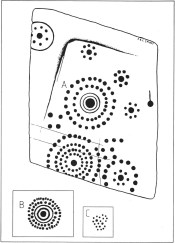Cup-and-Ring Stone (lost): OS Grid Reference – NX 709 489
Archaeology & History
This impressive carving was found somewhere in the vicinity of the well-known High Banks (01) cup-and-ring menagerie, with its clustered mass of cups and multiple rings. And the carving we see here possesses something of a similarity with its complex neighbour—but it remains lost.
The drawing was done by our old Scottish megalithomaniac Fred Coles, who discovered the carving when he visited the area around the beginning of the 20th century. It remained unpublished until fellow rock art student Maarten van Hoek (1990) explored the region and found it hiding away in the archives at the Stewartry Museum, Kirkcudbright. The multiple rings of cups surrounding central cups and cup-and-rings are very rare things indeed and this carving is utterly unique in the British Isles.
In Coles’ drawing, as well as the large carving, we have two other elements below, boxed. These are taken from a notebook found in the same Stewartry Museum and thought to have been done by a Mr G. Hamilton around 1866. In the lower-box, the double-ringed cup with its surround of two more rings of cup-marks was suggested at first by van Hoek (1990) to possibly be the same carving as that found by Coles. But he questioned this, sensibly, as the carved design ‘B’,
“comprises 35 cups (its diameter stated to be 21 inches / 51cm), whereas Coles’ diagram of ‘A’ shows only 24 outer cups. The unknown artist moreover says that, ‘The above (B) is one of a splendid group on Banks Farm.’ So this rosette (B) might be a completely different specimen altogether.”
I have to agree with him. In the second smaller box, ‘C’, the drawing of the cluster of cup-marks is taken from the same 19th century notebook in which the author said there was a cluster of
“70 to 100 small cups without any apparent system, except being in a group of 7 with cup in the centre—also 3 or 4 circles.”
No other details were given. Petroglyph explorers in the area should keep their senses peeled when meandering about here, for this and other missing carvings (High Banks 3).
References:
- Morris, Ronald W.B., The Prehistoric Rock Art of Galloway and the Isle of Man, Blandford: Poole 1979.
- van Hoek, M.A.M., “The Rosette in British and Irish Rock Art,” in Glasgow Archaeological Journal, volume 16, 1990.
© Paul Bennett, The Northern Antiquarian
